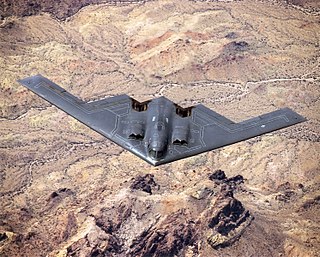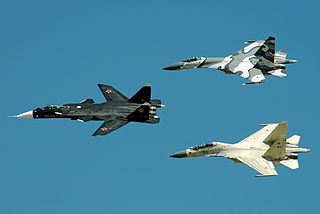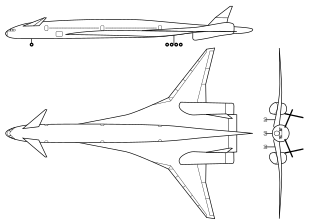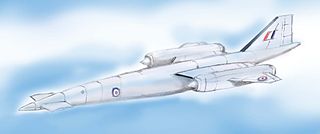
The British Aircraft Corporation (BAC) was a British aircraft manufacturer formed from the government-pressured merger of English Electric Aviation Ltd., Vickers-Armstrongs (Aircraft), the Bristol Aeroplane Company and Hunting Aircraft in 1960. Bristol, English Electric and Vickers became "parents" of BAC with shareholdings of 20%, 40% and 40% respectively. BAC in turn acquired the share capital of their aviation interests and 70% of Hunting Aircraft several months later.

A flying wing is a tailless fixed-wing aircraft that has no definite fuselage, with its crew, payload, fuel, and equipment housed inside the main wing structure. A flying wing may have various small protuberances such as pods, nacelles, blisters, booms, or vertical stabilizers.

Sir Barnes Neville Wallis was an English engineer and inventor. He is best known for inventing the bouncing bomb used by the Royal Air Force in Operation Chastise to attack the dams of the Ruhr Valley during World War II.

A supersonic transport (SST) or a supersonic airliner is a civilian supersonic aircraft designed to transport passengers at speeds greater than the speed of sound. To date, the only SSTs to see regular service have been Concorde and the Tupolev Tu-144. The last passenger flight of the Tu-144 was in June 1978 and it was last flown in 1999 by NASA. Concorde's last commercial flight was in October 2003, with a November 26, 2003 ferry flight being its last airborne operation. Following the permanent cessation of flying by Concorde, there are no remaining SSTs in commercial service. Several companies have each proposed a supersonic business jet, which may bring supersonic transport back again.

The British Aircraft Corporation TSR-2 is a cancelled Cold War strike and reconnaissance aircraft developed by the British Aircraft Corporation (BAC), for the Royal Air Force (RAF) in the late 1950s and early 1960s. The TSR-2 was designed around both conventional and nuclear weapons delivery: it was to penetrate well-defended frontline areas at low altitudes and very high speeds, and then attack high-value targets in rear areas. Another intended combat role was to provide high-altitude, high-speed stand-off, side-looking radar and photographic imagery and signals intelligence, aerial reconnaissance. Only one airframe flew and test flights and weight-rise during design indicated that the aircraft would be unable to meet its original stringent design specifications. The design specifications were reduced as the result of flight testing.

The Miles M.52 was a turbojet-powered supersonic research aircraft project designed in the United Kingdom in the mid-1940s. In October 1943, Miles Aircraft was issued with a contract to produce the aircraft in accordance with Air Ministry Specification E.24/43. The programme was highly ambitious for its time, aiming to produce an aircraft capable of a speed of at least 1,000 miles per hour (1,600 km/h) during level flight, and involved a very high proportion of cutting-edge aerodynamic research and innovative design work.

A swept wing is a wing angled either backward or occasionally forward from its root rather than perpendicular to the fuselage.

A variable-sweep wing, colloquially known as a "swing wing", is an airplane wing, or set of wings, that may be modified during flight, swept back and then returned to its previous straight position. Because it allows the aircraft's shape to be changed, it is an example of a variable-geometry aircraft.

The Boeing Sonic Cruiser was a concept jet airliner with a delta wing–canard configuration. It was distinguished from conventional airliners by its delta wing and high-subsonic cruising speed of up to Mach 0.98. Boeing first proposed it in 2001, but airlines generally preferred lower operating costs over higher speed. Boeing ended the Sonic Cruiser project in December 2002 and shifted to the slower but more fuel-efficient 7E7 airliner.

The Bristol Type 188 is a supersonic research aircraft designed and produced by the British aircraft manufacturer Bristol Aeroplane Company. It was nicknamed the Flaming Pencil in reference to its length and relatively slender cross-section as well as its intended purpose.

The Fairey Delta 2 or FD2 is a British supersonic research aircraft that was produced by the Fairey Aviation Company in response to a specification from the Ministry of Supply for a specialised aircraft for conducting investigations into flight and control at transonic and supersonic speeds. Features included a delta wing and a drooped nose. On 6 October 1954, the Delta 2 made its maiden flight, flown by Fairey test pilot Peter Twiss; two aircraft would be produced. The Delta 2 was the final aircraft to be produced by Fairey as an independent manufacturer.

The Vickers Windsor was a Second World War British four-engine heavy bomber, intended for high altitude flight. The Windsor was designed by Barnes Wallis and Rex Pierson at the Vickers-Armstrongs factory at Brooklands.

An oblique wing is a variable geometry wing concept. On an aircraft so equipped, the wing is designed to rotate on center pivot, so that one tip is swept forward while the opposite tip is swept aft. By changing its sweep angle in this way, drag can be reduced at high speed without sacrificing low speed performance. This is a variation on the classic swing-wing design, intended to simplify construction and retain the center of gravity as the sweep angle is changed.

The Avro 730 was a planned Mach 3 reconnaissance aircraft and strategic bomber that was being developed by Avro Aircraft for the Royal Air Force (RAF). It had been originally envisioned as a very high-speed aircraft to perform aerial reconnaissance missions, conforming with the requirements of Air Ministry Specification OR.330. Avro subsequently decided to modify the design of the proposed 730 in order to accommodate its arming with nuclear weapons; this change therefore meant that the type would be able to perform the nuclear weapons delivery mission as well, which had been called for under Air Ministry Specification RB.156T which sought a high speed reconnaissance-bomber aircraft.
The Vickers-Armstrongs V-1000 was a proposed jet-powered cargo aircraft that was designed to meet a requirement issued by the British Ministry of Supply which sought a strategic transport for the Royal Air Force (RAF) to support its strategic bomber fleet, particularly the V-bombers. The design bears many similarities to the Vickers Valiant, one of the V-bombers, but also featured substantial changes. In addition to its military application, both the Ministry and Vickers also intended to use the same basic design as the VC7, a six-abreast trans-Atlantic jet airliner for British Overseas Airways Corporation (BOAC).

BAC/Dassault AFVG was a 1960s project for supersonic multi-role combat aircraft with a variable-sweep wing, jointly developed by British Aircraft Corporation in the United Kingdom and Dassault Aviation of France.

The Bristol Type 172 was a proposed British long range four-engined bomber project developed by the Bristol Aeroplane Company. It is closely related to the Type 174 and Type 176 proposals.
Wild Goose was a research unmanned aerial vehicle (UAV) developed and flown by designer Barnes Wallis for his research into tailless variable-sweep aircraft incorporating a radical new control system and capable of high-speed, long-range performance.
Red Hebe was a large active radar homing air-to-air missile developed by Vickers for the Royal Air Force's Operational Requirement F.155 interceptor aircraft. It was a development of the earlier Red Dean, which was not suitable for launch by the new supersonic aircraft. Before progressing much beyond advanced design studies, F.155 was cancelled in the aftermath of the 1957 Defence White Paper which moved Britain's attention from strategic bombers to ballistic missiles. With no other suitable platform, Red Hebe was cancelled as well.
















